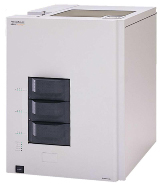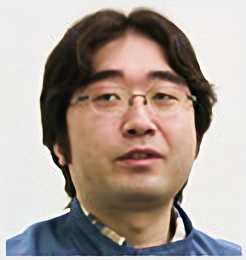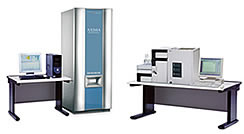
AccuSpot

INDUSTRY
Hydrocarbon Processing Industry (Petrochemical, Chemical)
Ključna riječ
Uvođenje usluga i proizvoda
AccuSpot
The unique Shimadzu SEC-AccuSpot system enables analyzing each component consecutively with MALDI-TOF MS, by automating all steps from separation and fraction collection by SEC (size exclusion chromatography) to adding matrix reagent or cationizing reagent to elution and spotting them onto MALDI plates. In this case, we talked to Dr. Taguchi at the Toray Research Center, who is involved in using AXIMA MALDI-TOF MS and SEC-AccuSpot systems to analyze polymer materials and, specifically, the structure of their trace components, regarding how he uses the system, its advantages, his requests, and so on.

*Podružnice i naslovi ispitanika su aktualni od vremena izvještavanja.
Toray Research Center, Inc.
URL
http://www.toray-research.co.jp/en/index.html
What is the reason for using the SEC-AccuSpot-AXIMA system?
In the field of organic analysis, compounds are identified by combining IR, NMR, and MS systems. For polymers and other similar substances, the structure of monomers can be determined from their repeat units. We use the SEC-AccuSpot-AXIMA system for that process.
I suppose a MALDI system alone would be adequate if you were only trying to look at molecular weight distributions. Is there a reason you are using size exclusion chromatography and what advantages has it provided?

Our samples can include everything from polymers to oligomers, additives, and solvents. Therefore, many of them include a broad mixture of polymer weights, from low to high, and the method used to separate them can be very important. We need to use a separation method capable of separating compounds by properties and by molecular weight. By using multiple techniques to measure the separated fractions, we can determine each compound. Basically, we use three measurement techniques - IR, NMR, and MS - but the separation step that precedes measurement is the most important one; this is where we focus much of our effort, trying to better separate components. We still often use large-scale GPC fractionation methods to separate fractions at the level of tens of milligrams for analysis using IR, NMR, or other methods. However, some samples are not available in large quantities or cannot be analyzed using MALDI. We feel the SEC-AccuSpot-AXIMA system has been especially effective in such cases.
I see. Thanks for sharing that. In how many cases, so far, has using the SEC-AccuSpot-AXIMA system enabled detecting peaks in samples where no ions were detected using MALDI without separation?
For large sample quantities separated by SEC, we first try using MALDI, but if that is not successful or we want to analyze a particular sample more carefully, we use the SEC-AccuSpot-AXIMA system. We often use it when regular separation methods fall short.
Do you eventually get results?

At times, we still don't see any peaks. However, in many cases, we finally see peaks after separation, though it depends on the properties of the compound.
I'm glad to hear that. Last year you gave a presentation at the 14th Symposium on Polymer Analysis at Tokyo regarding a case of analyzing an additive. Do you often find requirements from your customers to analyze trace components like that?
Actually, that was proposed by our company. The SEC-AccuSpot-AXIMA system can be used even if we have less than a milligram of sample, but so far, the techniques we use for separation require on the order of ten to several tens of milligrams. Otherwise, samples are prepared by separating, collecting, and drying them manually, then placing them on plates, which is very time-consuming work. Therefore, we prepared that proposal as a possible way to reduce the amount of this work.
What led to your company installing a SEC-AccuSpot-AXIMA system?

It started when we installed a MALDI system. Personally, I have been measuring polymer materials with a MALDI system since my university days, so I was aware of its advantages and disadvantages and knew that there were limitations to a regular MALDI system. Therefore, when I heard about an LC-MALDI system, I thought it might be useful for us and asked Shimadzu to make it resistant to organic solvents. Therefore, we already had ample need for such a system.
By MALDI system limitations, do you mean ion suppression? Trace components become no longer visible if samples contain contaminants, right?
That's right. Trace components are often no longer visible, overall, if polydispersity is extremely broad. Until now, in such cases we separated samples as needed, completely manually.
You mean, until now you were separating samples using conventional SEC, concentrating fractions, and spotting them onto plates with a pipette, then analyzing them with the MALDI system?
Yes, that's right. It was a tedious process that required repeatedly collecting and concentrating fractions, but we did it anyway when we were really determined to identify components. In addition, we had to remain next to the instrument the entire time, which required an extremely long time for separation and spotting. In contrast, the SEC-AccuSpot system does all the sample preparation automatically. Spotting is performed automatically after separation, so all we have to do is to place the plates in the system, which is a great help.
Do you think it will improve productivity?

Presumably. I think it takes about half the time that it used to.
Next, I'd like to ask you about analytical conditions. What type of columns, solvents, and other supplies do you mainly use?
We use a multi-solvent type microcolumn introduced to us when the system was being installed. However, we do not use aqueous solvents. We mostly use chloroform and THF, due to matrix considerations. For the matrix, we typically use dithranol and a sodium salt as a cationizing agent.
Since you have been using micro-scale columns, have you found any advantages over conventional columns?
The biggest advantage is being able to reduce the sample quantities used. We no longer worry as much about having enough sample. If the sample quantity is limited, it limits the techniques we can use. In particular, utilizing NMR can be difficult if sample fractions need to be further separated, so in such cases, MALDI is especially important.
I assume the sample quantity can vary quite a bit, depending on what is requested.
Yes, it can be completely different depending on the customer. Raw material manufacturers, for example, often provide a kilogram, but some customers ask us to analyze samples that are on the order of a few micrograms. Faced with such a wide variety of samples, we must offer proposals based on those techniques that are usable in each case, so having a wide range of choices is extremely valuable.
Currently, only UV detection is available for SEC-AccuSpot systems. Do you have an opinion about that?

Since only substances with sensitivity to UV are visible, it would be helpful to have some sort of universal detector like an RI detector, even with which it would still probably be difficult to see everything.
I suppose so. Considering the ion suppression caused by coexisting components, it would be better if all sample components were visible.
In the future, we hope to use the system not only for MALDI, but also for other instruments. Therefore, it would be great if we could get quantitative information about sample.
I understand. We'll work on that. Do you have any other requests for improving the SEC-AccuSpot-AXIMA system?
Currently, once the SEC-AccuSpot starts, it keeps spotting, but it would be nice if that were programmable. That works for now, while it is used with SEC, but if used for a different reason, we would want to separate samples by LC and use the AccuSpot to spot fractions, then analyze them with MALDI. In that case, if the AccuSpot continues spotting when the analysis is taking a longer time, it might stop before the analysis is finished. If it was programmable, we could specify the timing, which would be extremely helpful.
Yes, it would be a waste to be spotting when there is nothing there. Is the LC system you refer to a reverse-phase system?

Yes. We analyze a lot of mixtures, which in some cases can contain two or more components with the same molecular size. Furthermore, the more we separate the sample, the less sample quantity is available, so sometimes samples separated by SEC are separated again by a reverse-phase system. In such situations, it requires a huge number of fractionations, which can take a full day. Therefore, we want to try using the AccuSpot system as a simpler way to investigate such situations.
I understand. Some customers have asked about using instruments other than MALDI after SEC, but do you have any demand for such applications?

Currently, the system has a single function to spot samples on the MALDI plate, but if it could be used easily for other applications, that would be good.
By the way, what do you think about the spotting speed?
Given the current application, the speed seems reasonable for MALDI. We are using it at an orthodox 6 seconds.
It seems like a subtle difference between 6 seconds, 5 seconds, 4 seconds or other intervals, but apparently shortening the interval can cause interesting things to occur and can reveal different information. It could be due to the effects of suppression as well.
Are there any other aspects, such as ease-of-operation or functionality that you liked? And conversely, do you think there are any issues to be resolved?
More than anything, I appreciate being able to analyze samples with MALDI straight away with minimal preparation. Also, I appreciate the fact that it uses extremely small amounts of sample. These two aspects are great. Except for the programmable timing I mentioned earlier, I have not sensed any particular problems in terms of continuing to use it with our current MALDI system.
Thank you so much. I'm glad to hear that. How about in terms of software? For example, the AccuSpot has separate software from the LC software, but what are your impressions about that as a user?

At our company, we do a mixture of both conventional and micro work, so if software for the AccuSpot were added to the same program, settings and other aspects could be confusing and difficult to use. Also, there are a limited number of people that use the AccuSpot, so I think it is better to keep the software separate.
Next, I'd like to ask if you have any suggestions for improving the AXIMA.
There are no problems at all when preparing samples and using MALDI in normal applications. In terms of MALDI alone, I wish the CCD camera had a little bit better resolution. We were hoping to measure more pinpointed areas and feel that a little higher magnification would be nice. Other than that, though probably already developed, closer spacing of irradiation spots would be good.
I understand. We'll look into that. – Do you have any impressions about maintenance and repairs?

I think the matrix pump on the SEC-AccuSpot system got clogged one time. We try to be careful and rinse thoroughly after using salts, but perhaps sometimes it sits disused for a while or we do not maintain it quite adequately.
For normal amounts of salt, THF is probably adequate for dissolving the salt, but once the salt starts building up, THF or chloroform is no longer able to dissolve all the salt, so perhaps rinsing with water may be better. Even if the system is not being used, some sort of solvent should be injected or it should be rinsed about once a week.
Lastly, do you have any advice for others in the field of industrial materials? For example, even if you were to say "MALDI is great" or "never use MALDI" for industrial materials, that would be fine.
I see. Of course, MALDI is not sufficient in some cases and it is important to verify results using multiple techniques, which is particularly stressed at our laboratory. However, being able to measure samples "as-is" is a big factor. Previously, we had to rely on thermal decomposition GC/MS, which destroys the sample. Consequently, there was uncertainty about whether the visible peaks were real or not, which led to reliability issues. In contrast, MALDI is able to directly ionize the components of interest, which is especially useful for structural analysis. That is a huge benefit. I think many people still don't know about MALDI and I get the feeling that there is a clear split in opinion between those that have unrealistically high expectations and those that think it is completely useless. Applicability may be limited, but if it used with a clear understanding of its fundamental strengths and weaknesses, it can be an extremely useful tool. I hope it will be used to its full advantage.
Thank you so much for sharing your comments today.


The SEC-AccuSpot-AXIMA is a new system for analyzing polymers. By separating before MALDI-TOFMS measuring, it enables detecting ultra-trace components in polymer materials with high sensitivity. By automating sample processing steps, it enables higher productivity (reducing the overall analysis times to as little as 1/4 of previous methods). Dr. Taguchi of the Toray Research Center was one of the first engineers to propose the need and development of such a system to Shimadzu and provided extensive advice during development. Even in this interview, he provided additional valuable suggestions, such as to include other non-UV detectors, to enable the software to control the detailed timing of spotting, and to enable validating plates. In the future, we hope to incorporate each of these suggestions into research and development to make these instruments easier to use within the workflow where they are actually used. Furthermore, we hope the strengths of this system will be fully utilized in a wide variety of applications, to provide useful solutions for analyzing polymer materials.